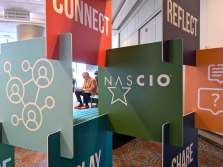Agile development helps state government avoid waste, improve project quality, NASCIO report says

Agile is spreading in state government, but it needs champions.
After teasing its initial findings earlier this year, the National Association of State Chief Information Officers (NASCIO) released its final report on the popular iterative development process during its annual conference in Austin, Texas, on Monday. The 35-page report, produced in conjunction with Accenture, includes a case study chronicling the adoption of agile by the State of Nebraska and distills 10 recommendations that NASCIO says represent “the most insightful first-hand knowledge of how agile can work in state government.”
In a panel discussion, state Chief Information Officers Ed Toner of Nebraska and Denis Goulet of New Hampshire shared their experiences introducing the process into state government and reflected on the report’s findings, such as the fact that half of those surveyed reported a belief that agile affords government greater efficiency and less risk amid IT projects.
Toner, who is championing the use of agile in Nebraska, said groups that have embraced the spirit of the process have seen improved efficiency.
“The real magic of agile to me is the psychology,” Toner said.
The process and the mechanics of agile are useful, Toner said, but the results come when groups adopt the spirit of agile development and begin doing performance management internally.
Agile — which NASCIO defines as “an iterative project management methodology that delivers differentiated, high-value solutions in rapid deployments and functionality and relies on frequent feedback and adaptation to reach desired outcomes” — has become increasingly favored in the private sector in recent years as a nimble alternative to traditional “waterfall” development. Government has been slower to adopt, but is gaining after hearing tales of success from advocates like Toner and Goulet.
NASCIO found that agile tends to be supported strongly by those who use it, with 70 percent of IT professionals surveyed reporting that it “helped avoid wasted money from ineffective IT projects.” Two thirds of those surveyed said agile “helped avoid large IT project failures,” and 58 percent said it “helped prevent programs that do not meet business needs.” Getting state government to try something new can be a hurdle, the CIOs said, but once people begin seeing what agile can do, they open up.
“You have to have early successes to win over your business customers,” Toner said. “Success breeds success. The word kind of spreads.”
For those trying agile for the first time, Toner recommended first finding the sweet spot.
“The first thing you have to look for is something that will touch all agencies,” Toner said.
Many businesses first see the agile process as an “additive time spend,” Goulet said, but it actually saves time because the products don’t need to be revised after a long development cycle — they’ve been refined and watched closely all along.
“You’ll see that what you’re asking for is exactly what you’ve got,” Goulet said.
NASCIO reports that in 2016, 85 percent of U.S. citizens expected “the same or more” more government digital services compared the private sector, making agile a necessity to iterate more quickly and make the most of their limited budgets.
“State governments do not have the resources to afford wasted investments,” NASCIO says in its report.
Indeed, the results of NASCIO’s report show that agile can allow work that is faster, more efficient, of a higher quality, more transparent, more strategic, and include improved customer engagement. “Improved customer engagement” was cited as the most common benefit in the survey, with 74 percent of respondents reporting “improved business ownership,” while 64 percent noted that agile helped achieve “greater alignment with business needs.”
Agile can get customers to pay faster, too, he said, recalling a time when a customer “notorious for not paying on time” paid just two days after the project was completed.
Getting teams in Nebraska state government to adopt agile has been a mixed bag, Toner said, but he’s playing the long game.
“Part of it is patience,” he said. “I’ll get you — now or later.”
The 10 recommendations included in the report, which can be downloaded freely from NASCIO, are:






